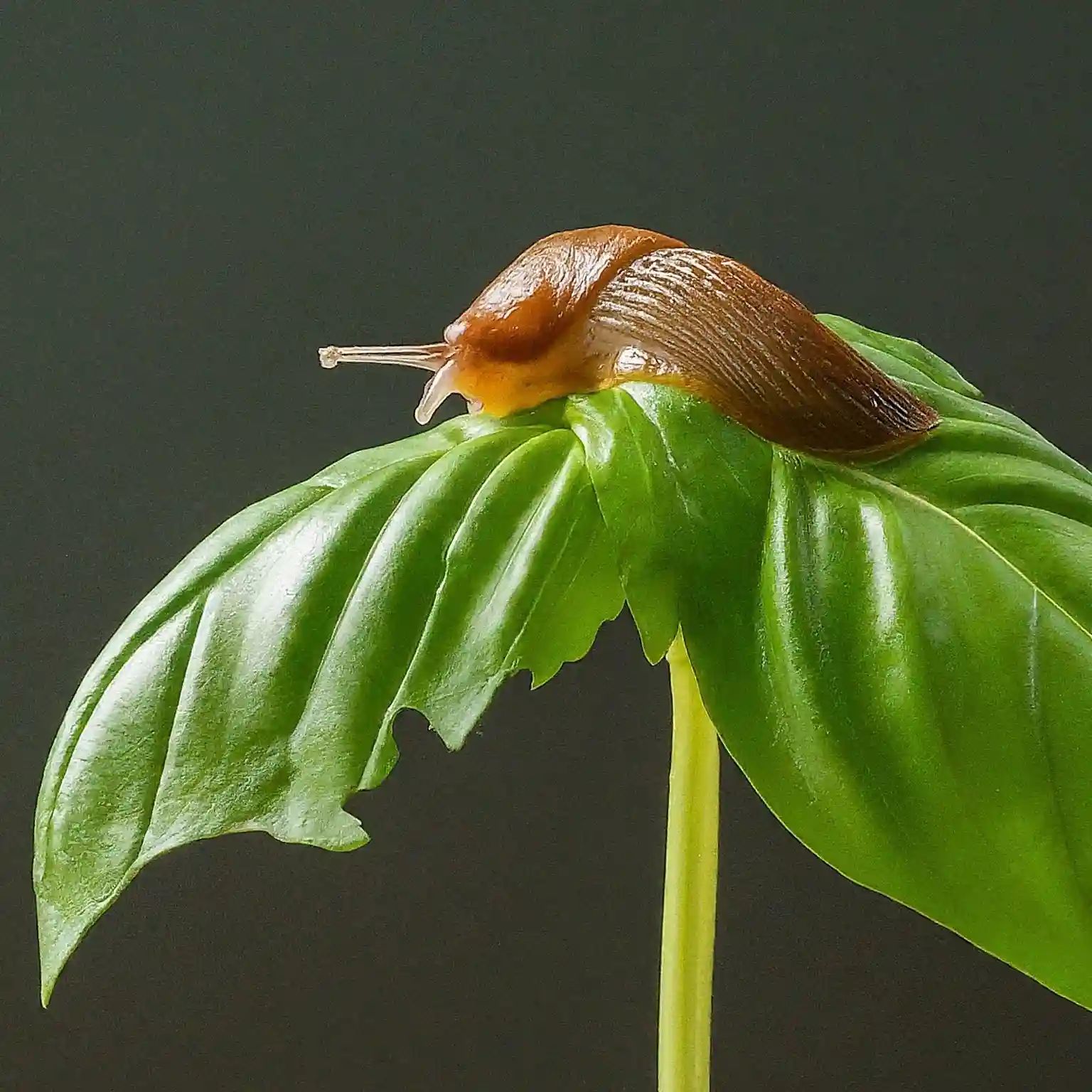What are the Most Common Pests in Basil? Your Guide to Protecting Your Herbs
Enjoying fresh, homegrown basil is one of summer’s greatest pleasures. Unfortunately, several pests also appreciate the flavorful leaves of your basil plant. Identifying and managing these common pests is key to keeping your herbs healthy and thriving.

The Big 7: The Must-Know Basil Pests
Let’s take a closer look at the primary culprits that can cause trouble in your basil patch:
1. Aphids
- Description: Aphids are tiny, pear-shaped insects in various colors like green, black, or yellow. They cluster on the undersides of leaves and tender stems.
- Damage: Aphids suck the sap from your basil, leading to stunted growth, yellowing leaves, and overall weakening of the plant. They also secrete a sticky substance called honeydew, which can promote sooty mold.
- Control:
- Spray off with a strong blast of water.
- Use insecticidal soap (see our article on How to Get Rid of Aphids on Basil Plants).
- Attract beneficial insects like ladybugs.
2. Japanese Beetles
- Description: These shiny, metallic green beetles with copper-colored wing covers are a major garden pest. Adults emerge in early summer.
- Damage: Japanese beetles devour basil foliage, creating a skeletonized, lace-like appearance on the leaves. Severe infestations can weaken or kill plants.
- Control:
- Handpick beetles in the early morning and drop them in soapy water.
- Neem oil can be effective in repelling and controlling them.
- Consult your local garden center for additional measures if the infestation is severe.
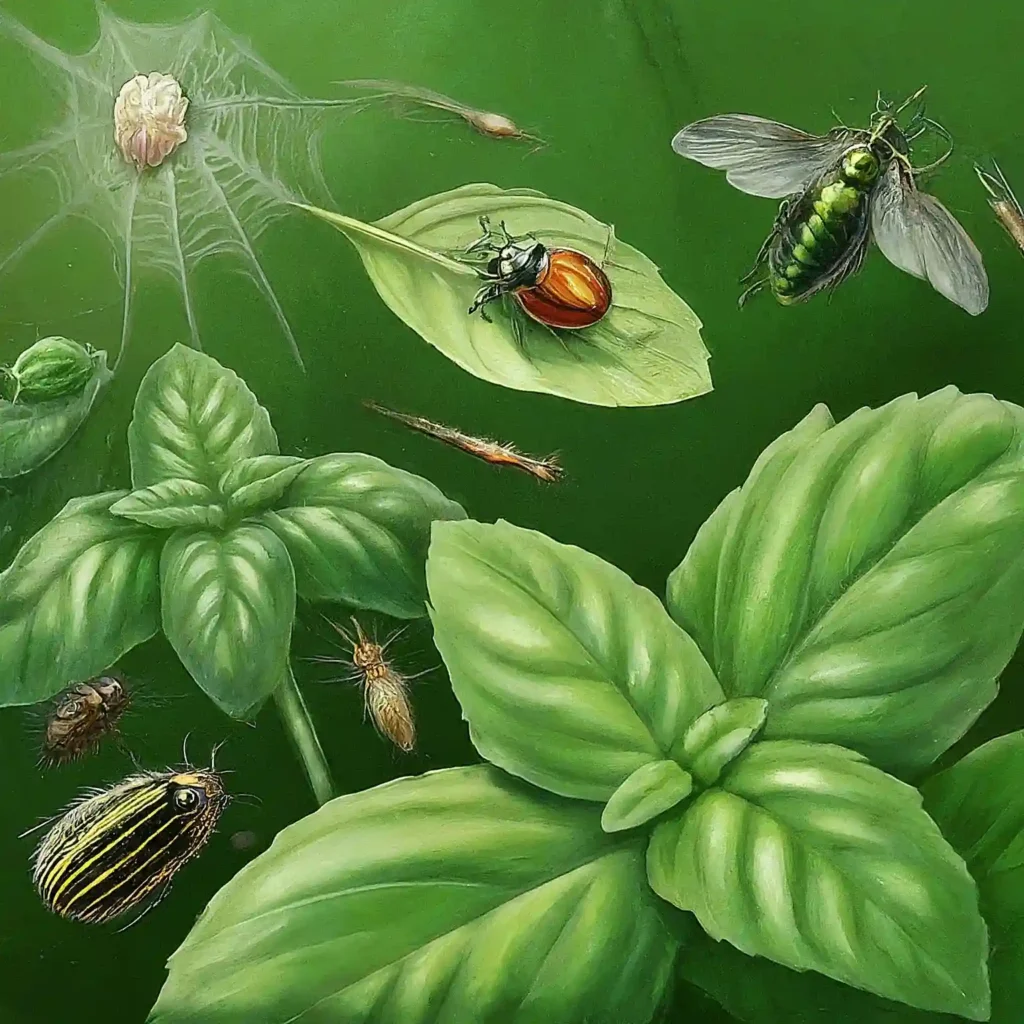
3. Slugs and Snails
Sligs and snails are the bane of many a basil grower! These slimy creatures relish the tender leaves of your basil, leaving behind unsightly holes and telltale silvery slime trails. Don’t despair; there are ways to fight back:
- Understanding their Habits: Slugs and snails are nocturnal and love moisture. They hide during the day in damp places, like under plant debris, rocks, or mulch. This is where you’ll need to focus your efforts.
- Hunting Time: Go on a slug and snail hunt after dark with a flashlight. Handpick them off your basil and drop them into a bucket of soapy water. It’s a little gross, but highly effective!
- Barriers of Defense: Create obstacles that make it difficult for them to reach your basil:
- Diatomaceous Earth: This fine powder is made from fossilized algae and its sharp edges lacerate slugs and snails. Sprinkle a ring around your plants (reapply after rain).
- Eggshells: Crushed eggshells have a similarly abrasive texture.
- Copper: Copper tape around pots or raised beds creates a barrier they’re hesitant to cross.
- Trapping: Shallow dishes of beer attract slugs and snails, and they’ll drown in the tasty trap. For a less wasteful solution, containers of yogurt or grapefruit rinds work too.
- Natural Predators: Encourage beneficial creatures like toads, birds, and ground beetles. They see slugs and snails as a tasty snack!
Additional Tips:
- Water Wisely: Water your basil in the morning at the base of the plant, allowing the soil to dry out slightly. Soggy conditions are a slug and snail paradise.
- Tidy Gardening: Minimize hiding places by removing fallen leaves, debris, and excess mulch near your basil.
4. Spider Mites
- Description: Spider mites are incredibly tiny arachnids (related to spiders), often only visible under magnification. They thrive in hot, dry conditions. Look for fine webbing on the undersides of leaves.
- Damage: Spider mites pierce leaves and suck out the sap, causing stippling (tiny yellow or white spots), discoloration, and eventually leaf drop. Heavy infestations can seriously weaken your basil plants.
- Control:
- Early Detection: Inspect your basil regularly, especially the undersides of leaves.
- Water Spray: A forceful blast of water can dislodge spider mites. Do this early in the day so leaves dry quickly.
- Insecticidal Soap: Effective for controlling existing infestations (check out our article on how to get rid of aphids on basil plants as it contains information on how to handle spider mites).
- Neem Oil: It offers both repellent and insecticidal properties.
5. Whiteflies
Whiteflies on basil can be a frustrating sight! These tiny, winged insects resemble little white moths and often take flight in a cloud when you disturb the plant. They’re masters at hiding, often found congregating on the undersides of leaves. Whiteflies damage basil plants in two ways:
- Sap Sucking: Like aphids and other piercing-sucking pests, whiteflies feed on your basil’s sap. This weakens the plant, causes yellowing or stippled leaves, and can lead to stunted growth.
- Honeydew and Sooty Mold: Whiteflies excrete a sticky substance called honeydew. This sugary mess attracts ants and, more troublesome, promotes the growth of sooty mold, a black fungus that blocks sunlight and hinders the plant’s photosynthesis.
Controlling Whiteflies on Your Basil
Dealing with whiteflies takes persistence, but here are several strategies to try:
- Blast them Away: Start by giving your infested plants a strong spray of water. This dislodges many of the adults and nymphs, and washes away some of the honeydew.
- Sticky Traps: Yellow sticky traps are remarkably effective at attracting and trapping adult whiteflies. Place them near your basil to reduce the population.
- Insecticidal Soap: For heavier infestations, insecticidal soaps work well. Be especially thorough in spraying the undersides of leaves where whiteflies and their eggs reside. Repeat applications may be needed.
- Neem Oil: This natural oil acts as both a repellent and insecticide. It can disrupt the nymph stage and deter adults from laying eggs.
- Beneficial Insects: Encourage natural predators like ladybugs and lacewings. They happily munch on whitefly eggs and nymphs.
Important Note: If your basil is in a pot, consider isolating it from other plants to prevent whiteflies from spreading.
6. Flea Beetles
Flea beetles might be small, but they can cause a surprising amount of damage to your basil plants. These tiny, hopping beetles get their name from their powerful hind legs that allow them to quickly jump away when disturbed. Here’s what you need to know:
Damage Done:
- “Shothole” Leaves: Flea beetles leave behind characteristic small, round holes in basil leaves. It can give the leaves a lace-like or “shothole” appearance. Heavy infestations can weaken plants and make the leaves unappealing for culinary use.
- Most Dangerous to Seedlings: Young, tender basil seedlings are highly susceptible to flea beetle damage. They can quickly overwhelm small plants.
Tackling Flea Beetles:
- Early Detection is Key: Monitor your basil closely, especially young plants. Flea beetles are easier to manage in smaller numbers.
- Row Covers: For seedlings or in high flea beetle areas, row covers offer excellent protection. Remember to remove them when your basil starts to flower for proper pollination.
- Sticky Traps: Blue sticky traps attract and catch flea beetles, helping to reduce their population.
- Diatomaceous Earth: Sprinkle this around your plants as a natural deterrent. The sharp particles irritate flea beetles.
- Insecticidal Soaps and Neem Oil: These options offer control, especially when flea beetle populations are high. Be sure to follow application instructions carefully.
Additional Notes:
- Flea Beetles Love Warm Weather: They’re most active in hot conditions.
- Weed Control Matters: Flea beetles can overwinter in plant debris and weeds. Keep your garden tidy to reduce potential hiding spots.
Flea beetles might not completely destroy established basil plants, but they can certainly diminish your harvest and make your basil less enjoyable. Proactive monitoring and quick action will help you stay ahead of these pesky beetles!
7. Thrips
- Description: Thrips are incredibly slender, tiny insects with fringed wings. They come in various colors like yellow, brown, or black.
- Damage: Thrips rasp at leaf tissue and then suck up the plant juices. This feeding causes silvery streaks, speckling, and distorted growth on basil leaves. Heavy infestations can stunt the entire plant.
- Control
- Blast of Water: A strong spray of water can dislodge some thrips.
- Sticky Traps: Blue sticky traps tend to attract thrips.
- Insecticidal Soap: Effective for managing infestations.
- Spinosad: An organic insecticide derived from bacteria that is effective against thrips.
8. Japanese Beetles
Japanese beetles are a gardener’s nightmare, and they have a particular fondness for basil. These shiny, metallic green beetles with coppery wing covers are voracious eaters. They descend on plants in swarms, skeletonizing leaves with astonishing speed. Here’s what you need to know:
- Damage Done: Japanese beetles chew through basil leaves, leaving only the veins and a ragged, lace-like appearance. They can devour entire plants if left unchecked.
- The Lifecycle Challenge: Adult beetles are active for several weeks in summer. The real trouble lies in the fact that they lay eggs in the soil, where the grubs hatch and feed on grass roots.
How to Combat Japanese Beetles on Your Basil
- Handpicking: The most reliable, though labor-intensive, method. In the morning, when beetles are sluggish, shake them off your basil into a container of soapy water.
- Neem Oil: This natural insecticide can disrupt feeding and repel beetles. It’s most effective when they’re first spotted.
- Row Covers: Fine mesh covers exclude beetles from your basil. Use them while the beetles are active in your area.
- Trap Crops: Some gardeners plant highly attractive plants (like roses or zinnias) away from their basil to lure the beetles. Just be careful this doesn’t backfire and bring more beetles to your yard!
- Milky Spore: A naturally occurring bacteria that infects Japanese beetle grubs in the soil. It can provide years of control if it becomes established, but it isn’t a quick fix.
Important: Avoid those Japanese beetle pheromone traps you might see advertised. These attract more beetles than they trap, potentially worsening your problem!
9. Fusarium Wilt in Basil
Fusarium wilt is a devastating fungal disease that can be a serious problem for basil growers. Sadly, there is no cure, making prevention and early identification critical. Here’s what you need to know:
How Fusarium Wilt Attacks:
- Soil-Borne Trouble: The Fusarium fungus lives in the soil and can persist for years. It enters your basil through the roots and spreads throughout the plant.
- Vascular Invasion: The fungus clogs the basil’s vascular system, the plant’s equivalent of blood vessels. This cuts off water and nutrient flow, leading to the distressing symptoms.
Signs of Fusarium Wilt:
- Wilting: Initially, wilting might appear during the hottest part of the day, with the plant seemingly recovering in the evening. However, the wilt becomes permanent, and leaves start to yellow and die.
- Stunted Growth: The basil plant stops growing and becomes stunted.
- Brown Streaks: If you slice through the stem, you may see dark brown streaks in the vascular tissue. This is a clear sign of Fusarium infection.
Managing Fusarium Wilt
- No Cure, Sadly: Once a basil plant is infected, there is no way to save it. Remove and destroy the infected plant (do not compost it) to prevent the spread of the fungus.
- Prevention is Key: Your best defense against Fusarium wilt is to plant resistant basil varieties. Look for cultivars labeled with “F” after the variety name, indicating Fusarium resistance.
- Crop Rotation and Sanitation: Avoid planting basil in the same location year after year. Practice good sanitation by cleaning your garden tools after use, especially if you’ve been working with infected plants.
- Seed Source Matters: Fusarium wilt can be seedborne. Purchase your seeds from reputable sources to minimize the risk.
Important Note: Fusarium wilt is specific to basil. It won’t spread to other unrelated plants in your garden. However, other types of Fusarium wilt exist, each attacking certain crops (think tomatoes, cucumbers, etc.).
10. Bacterial Leaf Spot in Basil
Bacterial leaf spot is a frustrating disease that can mar your basil’s beautiful leaves and weaken the plant. Caused by the bacterium Pseudomonas cichorii, it thrives in warm, humid conditions. Here’s what you need to know:
Signs of Bacterial Leaf Spot:
- Telltale Spots: Look for small, dark, water-soaked spots on your basil leaves. These spots might have a yellow halo around them. As the disease progresses, the spots enlarge and become angular in shape.
- Yellowing and Decline: The affected leaves may turn yellow and eventually drop off, leaving your basil plant looking ragged and unhealthy.
How it Spreads:
- Wind and Rain: Wind-driven rain is a primary way bacterial leaf spot spreads. The bacteria can splash from infected plants to healthy ones.
- Contaminated Tools and Hands: Always sanitize your gardening tools and wash your hands before and after working with different plants. This prevents accidental disease spread.
- Overhead Watering: Avoid watering your basil from overhead. This creates the perfect wet conditions for the bacteria to thrive and enter the plant tissue.
Managing Bacterial Leaf Spot:
- Remove and Destroy: As soon as you notice infected leaves, carefully remove and destroy them (don’t compost them!). This can help slow down the spread of the disease.
- Copper-Based Fungicides: These can offer some protection.
- Improve Airflow: Make sure your basil plants have good spacing to promote airflow. Avoid overcrowding, which creates humid microclimates.
- Water Wisely: Always water at the base of the plant in the morning, allowing the soil to dry out a bit between waterings.
Important: Bacterial leaf spot can be difficult to control, especially in very wet weather. Focus on preventative measures and act quickly if you spot any suspicious signs on your basil.
11. Grasshoppers on Basil
While not as persistent as some other basil pests, grasshoppers can still do significant damage. These long-legged munchers are generalist feeders, meaning they’ll happily snack on a variety of plants, including your basil. Here’s what to watch for and how to protect your crop:
Grasshopper Damage:
- Chewed Leaves: Grasshoppers leave behind ragged holes and chewed edges on leaves. They can defoliate a small plant quickly if left unchecked.
- Opportunistic: Grasshoppers are often a problem during hot, dry summers when other food sources become scarce. They may not stick around long, but can cause considerable damage in a short time.
Managing Grasshoppers on Basil:
- Physical Barriers: In areas with occasional grasshopper problems, lightweight row covers can be an effective deterrent. Secure the edges well to keep them from sneaking in.
- Handpicking: If you have just a few grasshoppers, handpicking can be effective.
- Natural Repellant: Neem oil can act as a repellent, deterring grasshoppers from feeding on your basil. It may need reapplications, especially after rain.
- Attract Natural Predators: Birds are excellent grasshopper hunters! Consider adding bird feeders or a birdbath to encourage them to visit your garden.
Additional Considerations:
- Tilling: Tilling the soil in the fall can expose grasshopper eggs, reducing their population the following year.
- Sacrificial Plants: Some gardeners plant taller, grasshopper-favorites (like sunflowers) near their basil to draw them away.
Note: Grasshoppers aren’t likely to destroy your entire basil crop, and healthy plants can usually tolerate some damage. However, keep an eye out during grasshopper season and take steps to protect your plants, especially young seedlings.
12. Caterpillars on Basil
While we often appreciate the beauty of butterflies, their larval stage – caterpillars – can be quite a menace in the basil patch! Many different types of moth and butterfly caterpillars find basil leaves a delicious treat. Let’s break down how to spot and manage them:
Signs of Caterpillar Infestation:
- Holes in Leaves: This is the most obvious sign. Caterpillars chew ragged holes in leaves, leaving them looking tattered.
- Frass (Caterpillar Poop): Look for small, dark pellets near the damage. This is a sure sign of caterpillar activity.
- Sightings: If you’re lucky enough (or unlucky, depending on how you look at it!), you might catch the caterpillar in action. Often, they blend in well, so look carefully, especially on the undersides of leaves.
Managing Caterpillars on Your Basil:
- Handpicking: The easiest solution for a small number of caterpillars. Inspect your plants regularly and drop caterpillars into soapy water.
- Bacillus thuringiensis (Bt): This naturally occurring bacteria is a highly effective, targeted control. It works specifically against caterpillars and is safe for beneficial insects.
- Row Covers: For heavy or recurring infestations, fine mesh covers exclude the adult butterflies and moths, preventing them from laying eggs on your basil.
- Beneficial Insects: Ladybugs, lacewings, and some parasitic wasps see caterpillars as a tasty meal. Encourage these natural predators in your garden!
Important Considerations:
- Caterpillar Identification: If possible, try to identify the kind of caterpillar you’re dealing with. This can help you determine if it turns into a butterfly you want to encourage or a pest moth.
- Damage Tolerance: Some caterpillar feeding might not be disastrous. A healthy basil plant can withstand a bit of munching. However, monitor the population to prevent heavy defoliation.
13. Leafhoppers on Basil
Leafhoppers are small, slender insects that can be tough to spot on your basil. However, they can still cause damage and contribute to pest problems. Here’s what you need to know:
How Leafhoppers Affect Basil:
- Piercing-Sucking Damage: Like aphids and whiteflies, leafhoppers feed on plant sap. This weakens your basil and can lead to stunted growth and yellowing leaves.
- Stippling: Their feeding causes small white or yellow stipples (spots) to appear on the leaves. A heavy infestation can give leaves a bleached-out appearance.
- Disease Vectors: While less common, some types of leafhoppers can transmit plant diseases, adding an extra layer of danger.
Managing Leafhoppers:
- Blast Them Away: A forceful spray of water can dislodge leafhoppers and their nymphs.
- Insecticidal Soap: This is an effective control option, especially for larger populations. Thorough coverage, including the undersides of leaves, is important.
- Neem Oil: This natural insecticide works as a deterrent and can affect the development of young leafhoppers.
- Encourage Beneficial Insects: Ladybugs, lacewings, and some parasitic wasps happily prey on leafhopper eggs and nymphs.
Important Considerations:
- Often a Secondary Problem: Leafhoppers might not be the primary pest on your basil, but rather another issue (like aphids) has weakened the plant, making it more attractive. Check for a combination of pests.
- Damage Isn’t Always Severe: While unsightly, the damage caused by leafhoppers might not be devastating to a healthy, mature basil plant. Focus on control for young plants and if you notice disease transmission.
Leafhoppers might be an occasional visitor to your basil patch. Keep an eye out for them, especially when dealing with other sucking insect infestations.
Other Potential Pests to Watch Out For
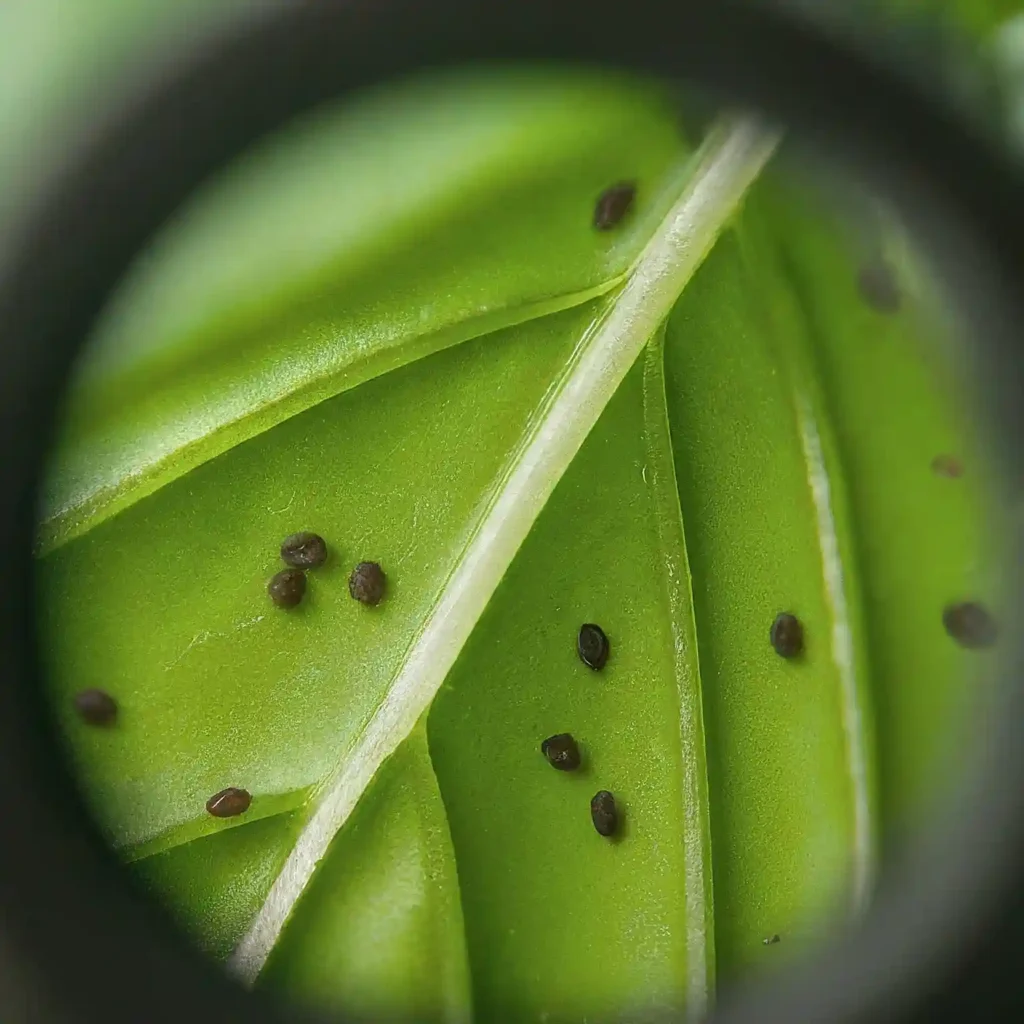
Nematodes: These microscopic roundworms inhabit the soil and feed on plant roots. Root-knot nematodes are a particular concern for basil, causing stunted growth, wilting, and yellowing. In severe infestations, these nematodes can significantly reduce basil harvests or even kill plants. Managing nematodes is challenging, but crop rotation, soil solarization, and selecting nematode-resistant basil varieties can offer some control.
Basil Downy Mildew: Unlike many pests, this is a fungal disease that thrives in cool, humid conditions. It manifests as yellow patches on the upper leaf surfaces, with a fuzzy, purplish-gray growth on the undersides. Infected leaves quickly die back, and severe cases can destroy whole plants. To minimize the risk of downy mildew, ensure good air circulation around your basil, avoid overhead watering, and look for downy mildew-resistant basil varieties.
Other Fungal Diseases: While less common than downy mildew, other fungal diseases can potentially harm basil. Fusarium wilt causes plants to wilt, yellow, and die, often starting from one side of the plant. Botrytis blight, or gray mold, produces a fuzzy gray growth on leaves and stems, especially during periods of prolonged wetness or high humidity. Maintaining proper spacing, watering at the soil level, and promptly removing any diseased plant material can help reduce the risk of these fungal problems.
How to Detect Basil Pests
Proactive detection of basil pests is essential for preserving the health and harvest of your plants. Here’s how to spot any unwelcome visitors early:
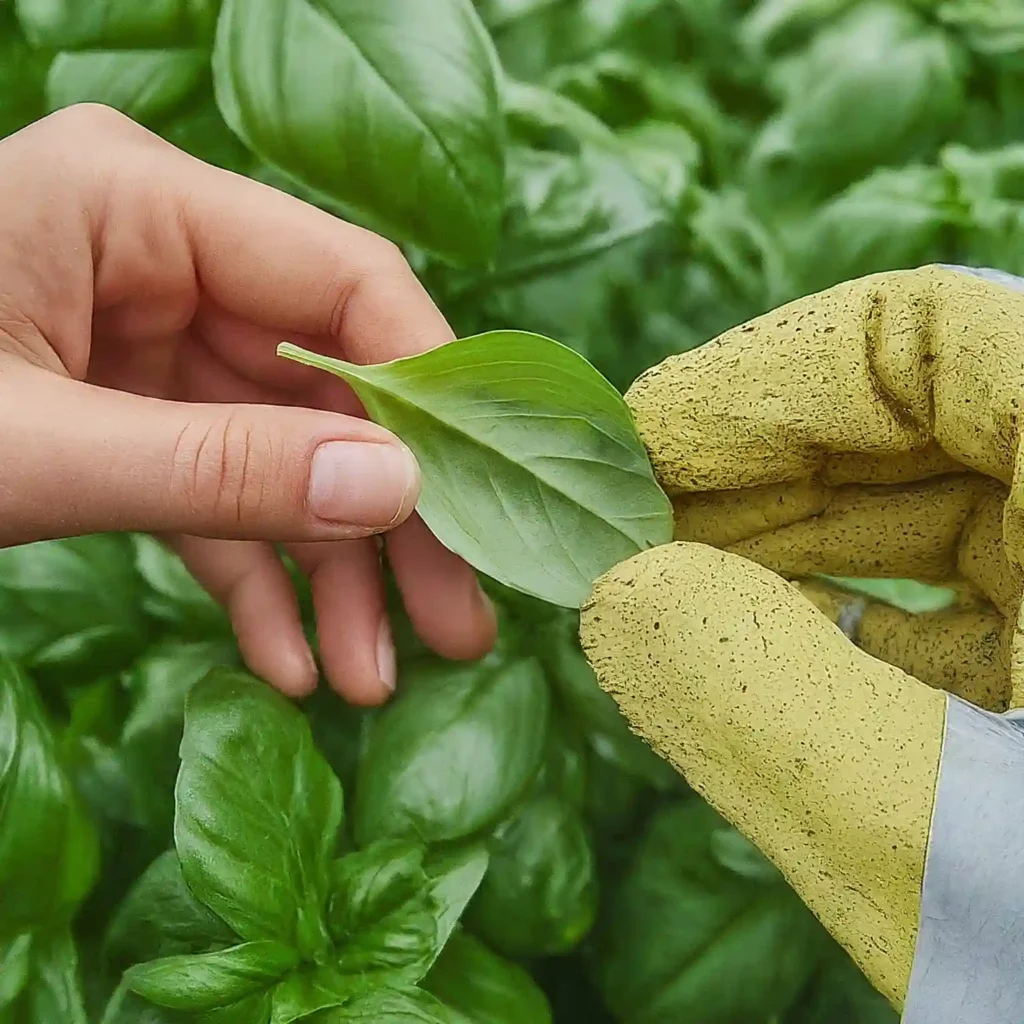
- Know the Culprits and Their Damage: Become familiar with the common basil pests we’ve discussed (aphids, Japanese beetles, slugs, etc.), and the specific signs of damage they cause. Skeletonized leaves, ragged holes, yellowing, stippling, webbing, and other symptoms should immediately catch your attention.
- Routine Checkups: Make inspecting your basil plants a regular part of your gardening routine. Aim for at least once a week, paying careful attention to the undersides of leaves where many pests like to congregate. Early detection allows for swift action and minimizes the potential damage.
- Sticky Traps: While used primarily for catching flying insects like whiteflies and thrips, yellow sticky traps serve a broader purpose: They act as an early warning system. Keep an eye on them – a sudden increase in trapped pests indicates a growing problem.
- Magnifying Tools: For tiny culprits like spider mites and thrips, a magnifying glass or jeweler’s loupe offers significant help. This gives you a close-up view and enables accurate identification of the culprit.
- Watch for Secondary Signs: Honeydew (the sticky excretion left by aphids and whiteflies) can attract ants and promote the growth of sooty mold, providing extra signals that pests are present.
Pro Tip: Take pictures of any unfamiliar damage or insects and seek assistance from your local garden center or online resources for identification and management recommendations.
Stopping Basil Pests Before They Start
The best way to combat basil pests is to prevent them from becoming a problem in the first place. Follow these key tips:
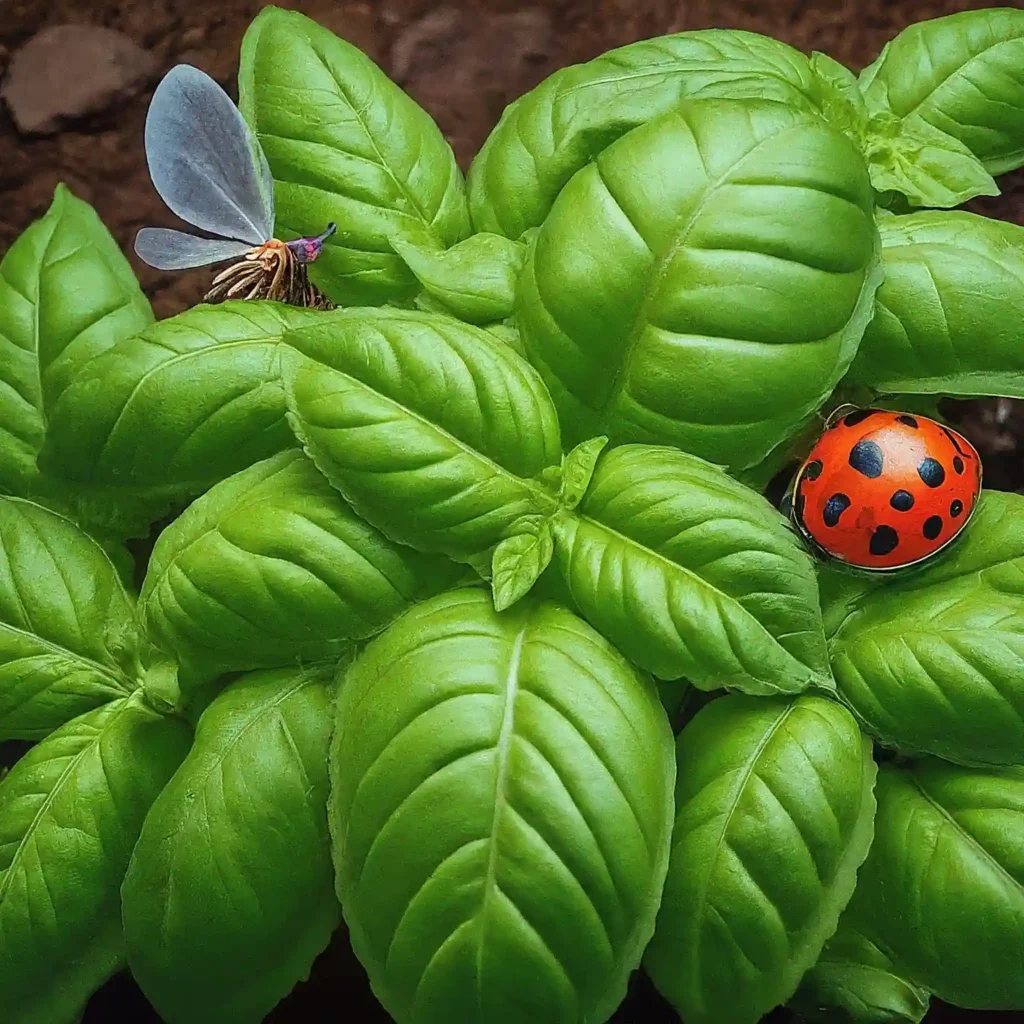
- Healthy Plants are Resilient Plants: Healthy basil is naturally better equipped to withstand pest pressure. Here’s how to give your basil a fighting chance:
- Proper sunlight: Most basil varieties require at least 6 hours of direct sun per day.
- Well-drained soil: Basil dislikes soggy roots. Ensure good drainage by amending your soil with compost if needed.
- Consistent watering: Water deeply and less frequently, allowing the top inch of soil to dry out between waterings. Aim to water your basil in the morning to encourage quicker drying of the foliage. (Check our guide here: – How to water your basil plant ).
- Adequate space: Proper spacing helps with air circulation, making it less hospitable for pests and fungal diseases.
- Fertilize: Light applications of an organic fertilizer keep your basil growing strongly (see our full guide: – Best soil for basil).
- Companion Planting: Choose plants that naturally deter basil pests or attract beneficial insects:
- Marigolds: Repel a wide range of garden pests.
- Nasturtiums: Can act as a “trap crop,” drawing aphids away from basil.
- Garlic and Chives: Their strong scent may discourage some pests.
- Herbs: Many herbs like mint, thyme, and rosemary help confuse and deter pests with their aromas.
- Mulching: Pros and Cons A layer of mulch around your basil can suppress weeds, regulate soil moisture, and add nutrients. However, mulch can also create cozy hiding places for slugs and snails. Consider lightweight mulches that dry quickly like straw, or forgo mulch entirely if slugs are a consistent problem.
- Crop Rotation: Avoid planting basil in the same spot year after year. Crop rotation disrupts pest lifecycles and reduces disease pressure in the soil.
- Beneficial Insects – Your Garden Allies: Ladybugs, lacewings, and various predatory wasps feed on many common basil pests like aphids. Make your garden attractive to these helpful insects by including flowering plants for nectar sources and avoiding broad-spectrum insecticides.
Treating Basil Pest Infestations
Despite your best efforts, a pest infestation may still occur. It’s essential to manage it quickly to protect your basil harvest. Here’s a tiered approach:
Natural/Organic Methods
Always attempt less aggressive interventions first, especially since basil is an edible crop.
- Handpicking: For larger pests like Japanese beetles, slugs, and snails, removal by hand is highly effective, especially during their early morning or evening activities.
- Strong Water Spray: Use a powerful stream of water to dislodge aphids, spider mites, and thrips. Repeat regularly for sustained control.
- Insecticidal Soap: Highly effective for various common basil pests. Ensure thorough coverage, including the undersides of leaves.
- Neem Oil: Made from the neem tree, this natural insecticide offers repellent and control properties against numerous pests. Follow dilution instructions closely and spray as needed.
- Diatomaceous Earth: This fine, powdery substance creates abrasive barriers that irritate and dehydrate many crawling insects. Sprinkle it around the base of your basil plants or even lightly dust the foliage.
Chemical Controls
- Use as a Last Resort: Pesticides have adverse effects on non-target insects and pollinators. If resorting to chemical solutions, it’s vital to ensure suitability for edibles like basil.
- Research Carefully: Consult your local garden center or extension service for specific product recommendations suitable for your pest problem and your region.
- Follow Instructions Precisely: Thoroughly read and follow label instructions for correct usage, concentration, and safety precautions.
Important Note: When applying any treatment, avoid doing so during high temperatures or directly in the hot sun. Early morning or evening is ideal to prevent scorching delicate basil leaves.
Conclusion
Don’t let pests munch their way through your basil harvest! By understanding the most common offenders, practicing proactive prevention methods, and employing effective treatment strategies when necessary, you can keep your basil plants thriving. Healthy, robust basil naturally has greater resilience against pests and will offer you abundant, flavorful leaves all season long.
Call to Action: Need further help protecting your basil or have questions about a specific pest problem? Visit [Basil Secrets] for a wealth of basil-growing resources and pest management tips.
People Also Ask
Can I still eat basil with pest damage?
In most cases, yes. Inspect leaves carefully, remove severely damaged ones, and thoroughly wash all basil before use. Cosmetic damage from pests often doesn’t affect the flavor or safety. However, severely damaged plants or plants with heavy sooty mold growth (indicating significant aphid/whitefly activity) are probably best discarded.
How do I get rid of pests on my basil plants organically?
The natural/organic methods in the “Treating Basil Pest Infestations” section are perfect choices! Start with methods like handpicking, strong water spray, insecticidal soap, and neem oil. These measures offer effective control while safeguarding beneficial insects and minimizing environmental impact. (We have a few guides on pest control like how to get rid of aphids.
What attracts pests to basil?
Several factors make basil enticing: stressed, unhealthy plants are highly susceptible to pests. Insufficient watering, poor light conditions, or nutrient deficiencies leave basil weakened. Insects seeking out tender leaves can easily attack such plants. Also, some specific pests may be attracted to the smell of the basil itself.
Will basil recover from pest infestation?
Yes, depending on the severity of the damage and the overall health of the plant. Timely intervention and treatment are critical. Once pests are eradicated, regular watering, adequate sunlight, and a little fertilizer can encourage your basil plants to bounce back with new, healthy growth. (How to keep your basil plant alive – the complete guide.
